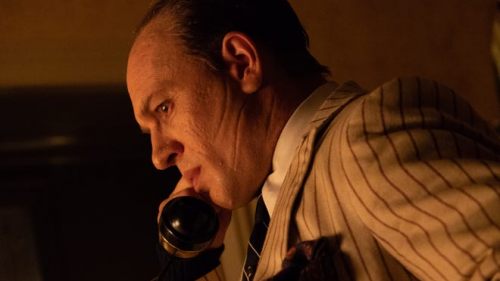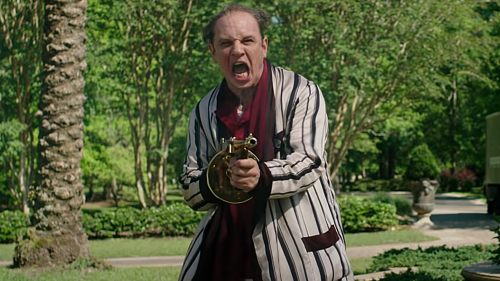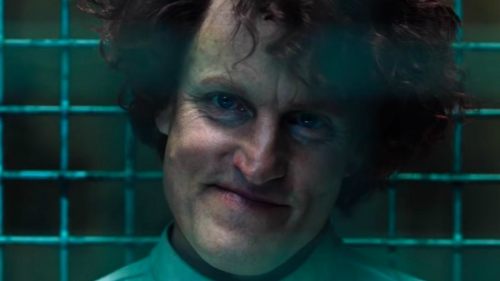Tom Hardy: Public Enemy Number One
Hollywood has never really known what to do with Tom Hardy. Memorable as his big bad Praetor Shinzon was, STAR TREK: NEMESIS didn’t propel him to British Bad Guy stardom, and fighting a different captain of the USS Enterprise for Reese Witherspoon’s heart in THIS MEANS WAR didn’t make a case for him as either a romantic lead or action star. Even the juggernaut that is comic book movies couldn’t find him a hero to play until the split-personality weirdness of VENOM, soon to receive a sequel.
Yet even in small supporting roles in BLACK HAWK DOWN, MARIE ANTOINETTE or THICK AS THIEVES, Tom Hardy commands attention. His furrowed brow, full lips and always-attentive eyes that instantly flick between guarded intelligence full of coiled menace and delicately-telegraphed emotionality make him a compelling sight even before he layers on his personal brand of character delineation through robust choices: a posture, a walk, a turn of the head, a physical transformation, and, most notoriously, a voice.
Hardy’s latest foray into character creation is CAPONE, Josh Trank’s much-delayed portrayal of the last syphilitic and dementia-ridden days of Prohibition-era Chicago mobster Al Capone. The trademarks of his process are once more on display in a portrayal of arguably the most famous gangster of them all that also represents the culmination of a career-long series of roles that have taken Tom Hardy from the bottom rungs of organised crime to its very top.
This journey starts with Matthew Vaughn’s directorial debut LAYER CAKE, in which Hardy plays the coke-dealer protagonist’s chemist and sidekick Clarkie. Despite limited screen time, the way Hardy directs his gaze and counterpoints stillness with nervous tics — stroking an eyebrow, twisting a card between his fingers — depicts an observant intellect as Clarkie ponders his next career move.
Still on that bottom rung, Vaughn’s erstwhile creative partner Guy Ritchie put Hardy at the heart of ROCKNOLLA as getaway driver Handsome Bob, who happens to be gay. Carving his own space within the ensemble cast, Hardy slides effortlessly between cocky and camp as the plot demands, but never allows Bob to become a caricature which might puncture the film’s mockery of homophobia.
Hardy’s ability to be so mercurial anchors BRONSON, Nicolas Winding Refn’s surrealist biopic of Britain’s most violent criminal who adopted the name of DEATHWISH star Charles Bronson. Perversely afforded vast freedom in a film largely set in prisons, Hardy’s Bronson is terrifying in both physicality and performance, but he’s also tender and playful, often enough all in the same scene, even in the same costume during a striking split-personality monologue played as a vaudeville act. Singing, dancing, shouting and fighting, BRONSON displays all of Hardy’s versatility along with a complete lack of vanity: few other actors would be willing to spend so much time on screen stark naked and covered in grease or paint with their eyes hidden behind dark glasses.
Progressing through the gangster ranks, LAWLESS finds Hardy playing Forrest Bondurant, a rural bootlegger running a miniature version of Al Capone’s operations. Taciturn and menacing, Forrest exemplifies the characters played by Hardy who use a blend of smarts and controlled violence to impose order on their life but are stunned when they find themselves outwitted and forced to confront their own mortality. The film’s another ensemble piece but Hardy’s brooding presence edges its nominal star Shia LaBeouf aside without indulging in scene-stealing histrionics.
Hardy’s even more contained in THE DROP, playing New York bartender Bob Saginowski as a mush-mouthed simpleton for the better part of the film before slowly unpacking the extent of Bob’s mob-related activities in the simple act of methodically wrapping a hoodlum’s hacked-off arm. This would be James Gandolfini’s final film role and in the scenes they share it’s possible to detect Hardy, still in character, revel in playing opposite an actor of such stature who is also irrevocably entwined with the modern popular conception of a mobster.
As Al Capone was to 1920s Chicago gangland, the Kray twins were to 1960s London, and even today Ronnie and Reggie are revered in their old stomping grounds depicted in LEGEND as written and directed by Brian Helgeland, whose gangster movie credentials include co-writing the script for L.A. CONFIDENTIAL. It’s a schizophrenic film, unsure if it wants to be a period piece, a romp through Swinging London or a character study, but this, in turn, plays into its casting of Tom Hardy as both twins, who coincidentally befriended Charles Bronson while in prison.
Hardy gives a masterclass in creating characters who, even when dressed in identical suits, are totally distinct: Reggie is the puppy, upright, bright-faced, charming and urgent whereas Ronnie is the pit bull, hunched and lumbering, his lower jaw thrust forward by his brutishness. Even setting aside Ronnie’s spectacles, there’s never any doubt which Kray is which, especially during the set-piece nightclub brawl in which Hardy goes to town on himself. Yet once the Fred Astaire-like drainpipe climbing and discomfiting of American mobsters is done, he bleeds these performances together as Ronnie mellows and Reggie’s temper gets the better of him. As with so many of his characters, Hardy doesn’t attempt to extract sympathy for these men but simply allows their interior lives to illuminate their actions.
If CAPONE finds Hardy reaching the top of the ladder, the question is where his gangster career can go next. The rise and fall of organised crime’s major figures has been charted in hundreds of movies going back to the 1930s, whether told straight, fictionalised, distilled into composite characters or dealt with in the margins of other gangster tales, but there’s one in particular whose story is yet to be explored in film: Johnny Stompanato.
An Illinois ex-Marine who abandoned the Turkish wife he met in China to move to Los Angeles, Stompanato ran a gift store before falling in with the mob and becoming an enforcer for Mickey Cohen’s outfit seen in BUGSY, L.A. NOIRE and GANGSTER SQUAD. Stompanato dated and married a string of Hollywood actresses including Ava Gardner (despite being warned off by Frank Sinatra), but it was his relationship with Lana Turner, depicted in a comic scene in L.A. CONFIDENTIAL, that was the ugly final act of his life.
So tempestuous was this affair that Stompanato flew to England in a fit of jealous rage to confront Turner’s co-star Sean Connery on the set of ANOTHER TIME, ANOTHER PLACE, only to have his ass handed to him by the future James Bond and subsequently be stabbed to death by Turner’s daughter Cheryl Crane in what was deemed a justifiable homicide. It’s a meaty, fascinating and multilayered gangster tragedy in which Tom Hardy would shine as Stompanato.
Of course, there are fictional gangsters waiting to be adapted or rebooted, and should a remake of THE GODFATHER ever get off the ground Hardy’s guaranteed to be asked about playing Vito Corleone and resolving the comparisons drawn between him and Marlon Brando once and for all.
One thing’s for sure: in a career full of left-field choices which don’t fit any Hollywood template Tom Hardy’s fearless commitment to his craft means that whatever he does next will be nothing less than enthralling.



